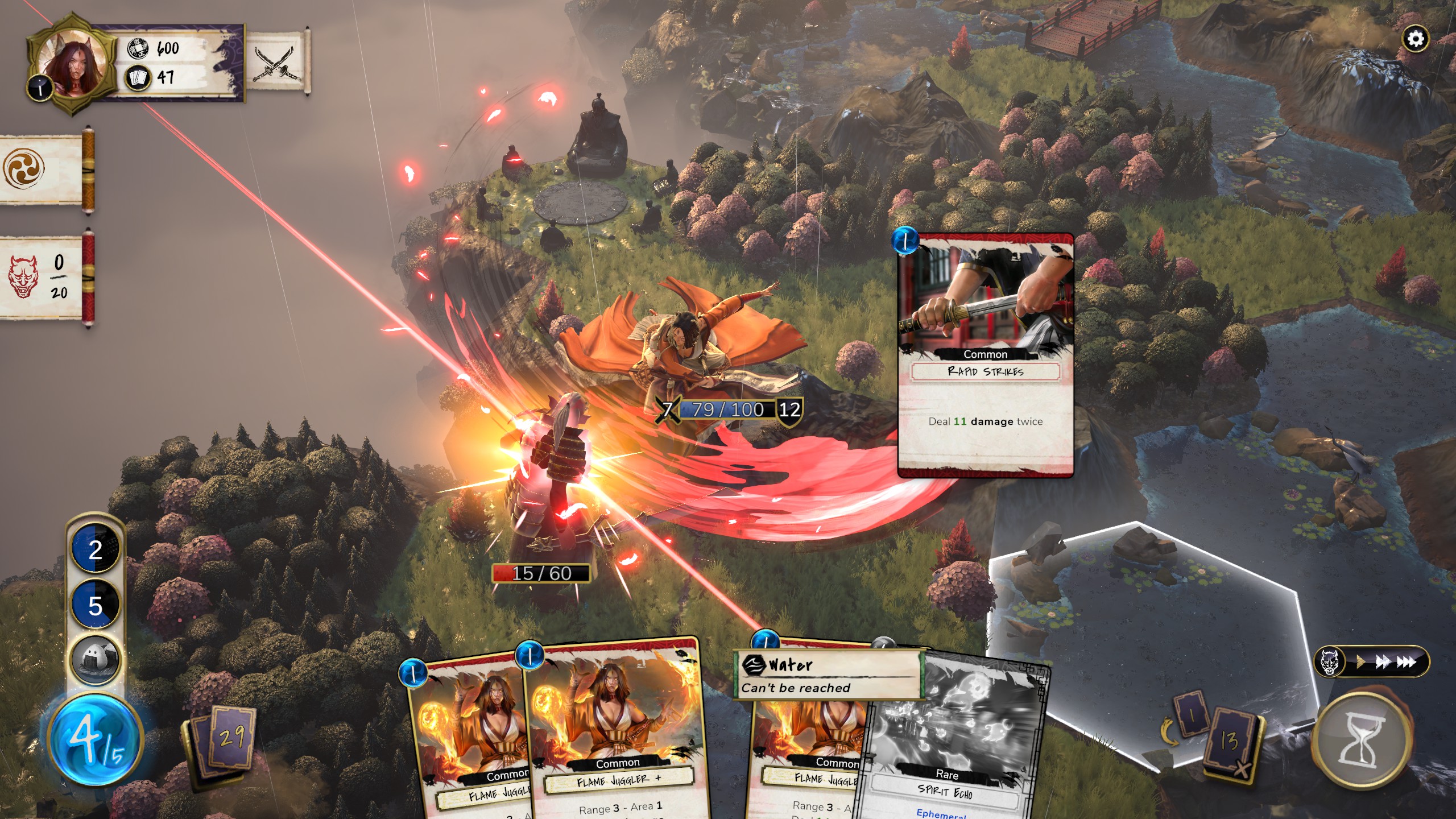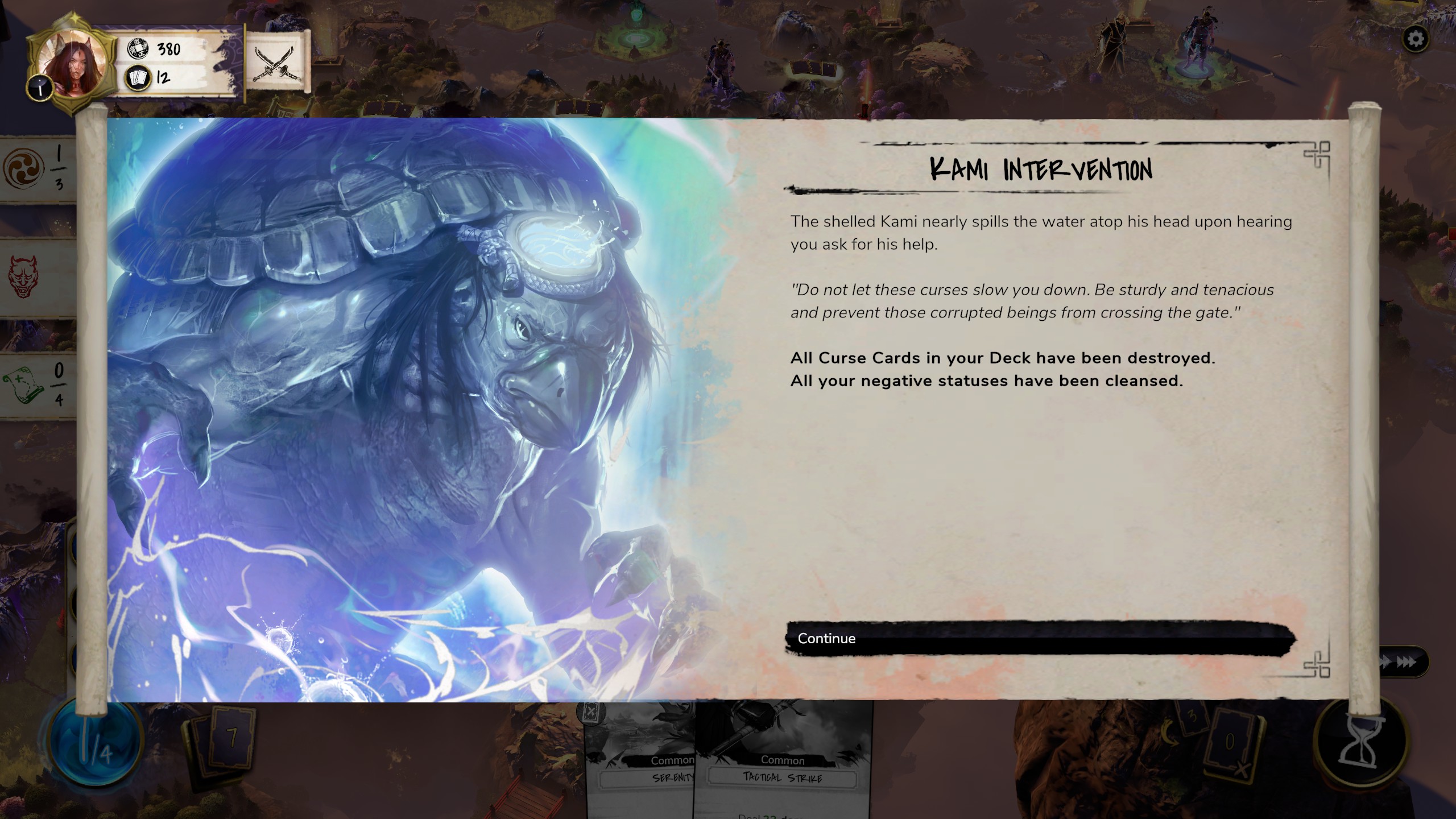Our Verdict
If you found Slay the Spire's oppressiveness off-putting, Mahokenshi's easier and dressed up in a pretty kimono.
PC Gamer's got your back
What is it? Part card game, part strategy game, part postcard from Japanese myth.
Expect to pay: $25/£21
Release date: January 24, 2023
Developer: Game Source Studio
Publisher: Iceberg Interactive
Reviewed on: Windows 10, Ryzen 9 5900X, 32GB RAM, RTX 3080
Multiplayer? No
Link: Official site
Mahokenshi is basically Slay the Spire with samurai wizards, and that's a solid selling point right there. It's a deckbuilder, the kind of game where you start with a set of rubbish cards and accumulate better ones as you work towards your goal, but one that tweaks the genre conventions in some unusual ways. Plus, you get a katana.
The theme turns out to be the least impactful part of Mahokenshi, a thin layer of second-hand Japanese folklore on top of the familiar elements. The mahokenshi are mystic warriors who've made deals with divine spirits for power, and there are four to unlock, each with their own deck. The one who cut a deal with a spider gets cards with poison and stealth effects, while the one whose powers come via a turtle spirit gets defense boosts and damaging spikes. In between fighting goblins, bandits, and cultists, these four face the occasional oni, while the item that lets them ditch useless cards is a kimono for some reason. The Japanese-ness is pretty superficial is what I'm getting at.

The structure is what really differentiates Mahokenshi from other deckbuilders. You play on a hexgrid, spending action points to manoeuvre your samurai across the floating Celestial Islands to find treasure, quests, power-ups, and so on. Instead of a randomized Spire or the mix-and-match Hell of Monster Train, all of its 18 missions have pre-determined layouts and goals, each telling a little story. One began with a tense chase, four feral oni pursuing me through the forest toward a castle. That affected the deck decisions I made, making movement cards more valuable than normal, and altered the way I played.
In other deckbuilders you just want to find an overpowered combo, then delete every card from your deck that doesn't help you pull off that combo. The missions in Mahokenshi, whether protecting villagers or sealing portals, add an extra layer of things to consider beyond finding the most outrageously broken set of cards to pair.
Another difference is that Mahokenshi is much easier. Only one mission gave me trouble, and that turned out to be my own fault. What seemed like a race against time, with four cultists casting buffs on an Oni King in the centre of the map, was actually much simpler. I should have been following the way of the turtle spirit, slow and steady, instead of rushing in.

Since the Oni King doesn't attack until you kill all four cultists, or mis-click and stand on a hex that's too close to him like I did one time, the best approach was to murder three of the hooded jerks then explore every corner of the map for power-up altars, markets to buy cards, dojos to upgrade cards, and gold to pay for the buying and upgrading. After boosting every stat and building the perfect deck, he didn't stand a chance even though he'd been getting hulked up on magic steroids at the same time. Even when a mission has an explicit time limit, in Mahokenshi it's always best to spend as long as possible gathering your strength.
The mahokenshi earn xp and level up individually, which does encourage you to stick with one character. That said, you'll hit max level fast, and every story mission you unlock is accompanied by a side mission or two that's even easier and can probably be tackled with the level one fox-powered lady you just unlocked. Plus there are buffs you pay for with crystals earned for completing optional challenges—like meditating at every altar on a map, or winning before three of the peasants you're supposed to protect die—that apply to every character.

While I was playing Mahokenshi I had a decent time, but I can't imagine I'll ever think of it again. It's a slight game, one I made it through in 20-ish hours and didn't really dwell on between sessions. The backstory barely exists, with a magic sword that needs to be reforged, evil cultists who plan to open portals to the Underworld, and basically nothing you couldn't rinse off and replace with a completely different cast of fantastical heroes and monsters. Combined with the breezy lack of challenge, it's about as filling as a single Pocky stick. For those 20 hours it did compel me, though.
If you found Slay the Spire's oppressiveness off-putting, Mahokenshi's easier and dressed up in a pretty kimono.

Jody's first computer was a Commodore 64, so he remembers having to use a code wheel to play Pool of Radiance. A former music journalist who interviewed everyone from Giorgio Moroder to Trent Reznor, Jody also co-hosted Australia's first radio show about videogames, Zed Games. He's written for Rock Paper Shotgun, The Big Issue, GamesRadar, Zam, Glixel, Five Out of Ten Magazine, and Playboy.com, whose cheques with the bunny logo made for fun conversations at the bank. Jody's first article for PC Gamer was about the audio of Alien Isolation, published in 2015, and since then he's written about why Silent Hill belongs on PC, why Recettear: An Item Shop's Tale is the best fantasy shopkeeper tycoon game, and how weird Lost Ark can get. Jody edited PC Gamer Indie from 2017 to 2018, and he eventually lived up to his promise to play every Warhammer videogame.


